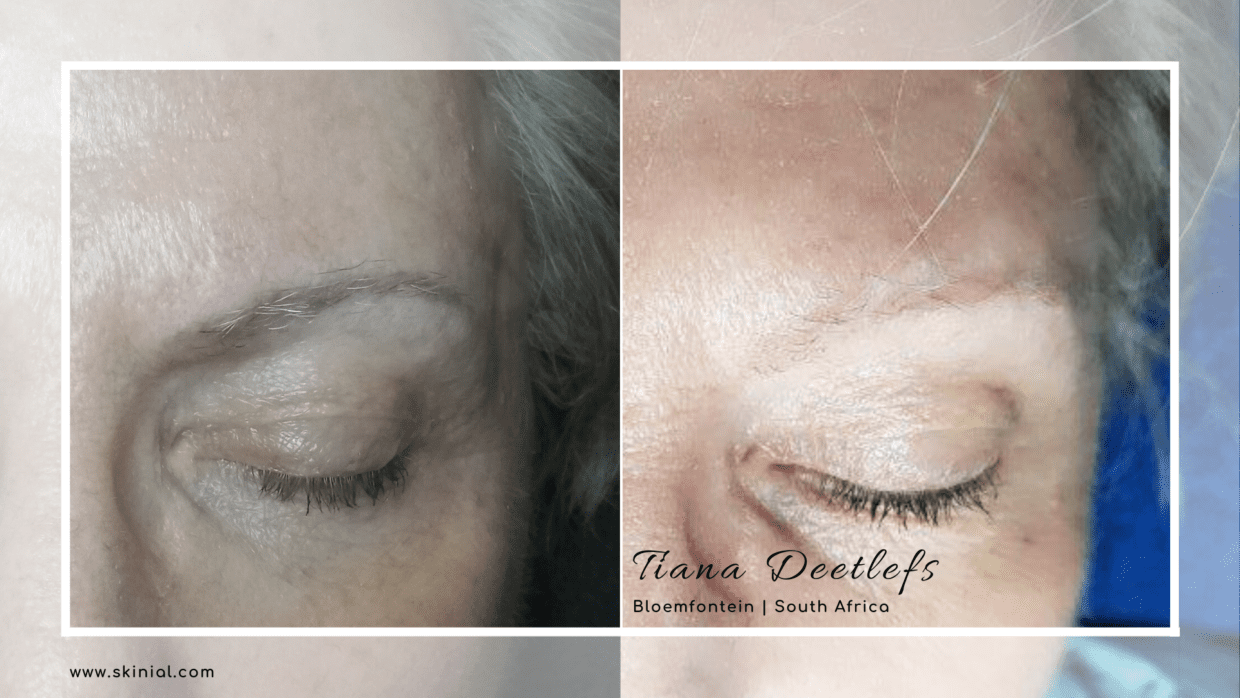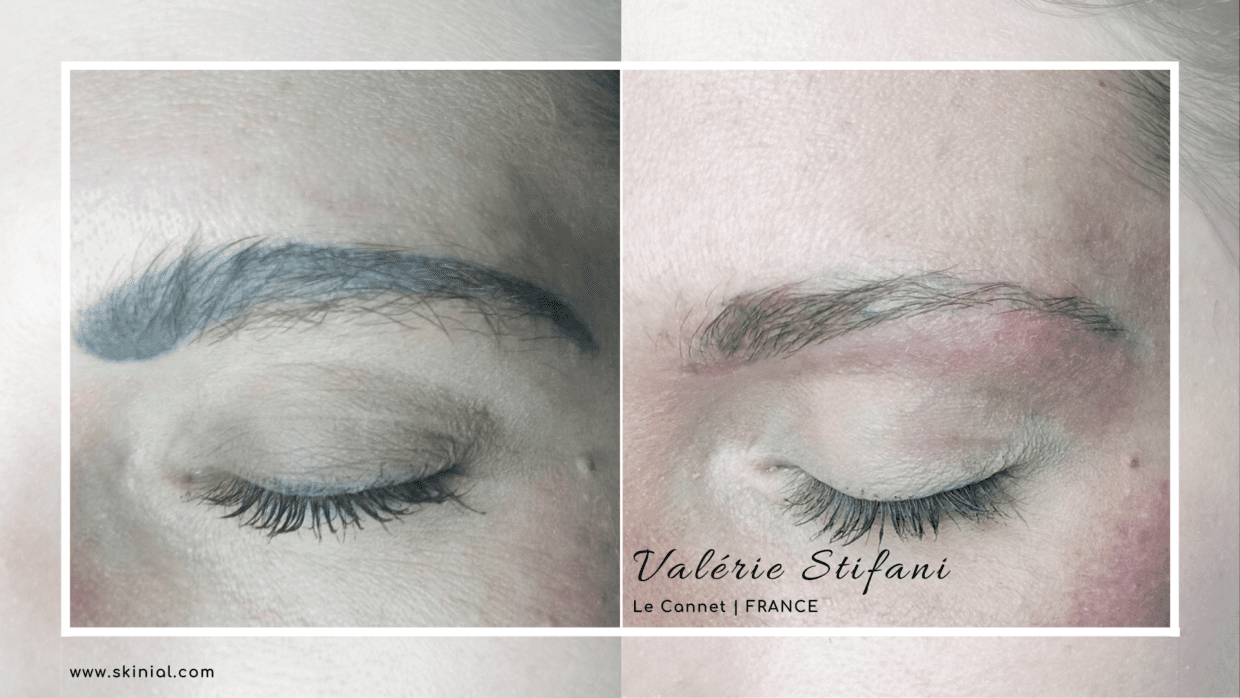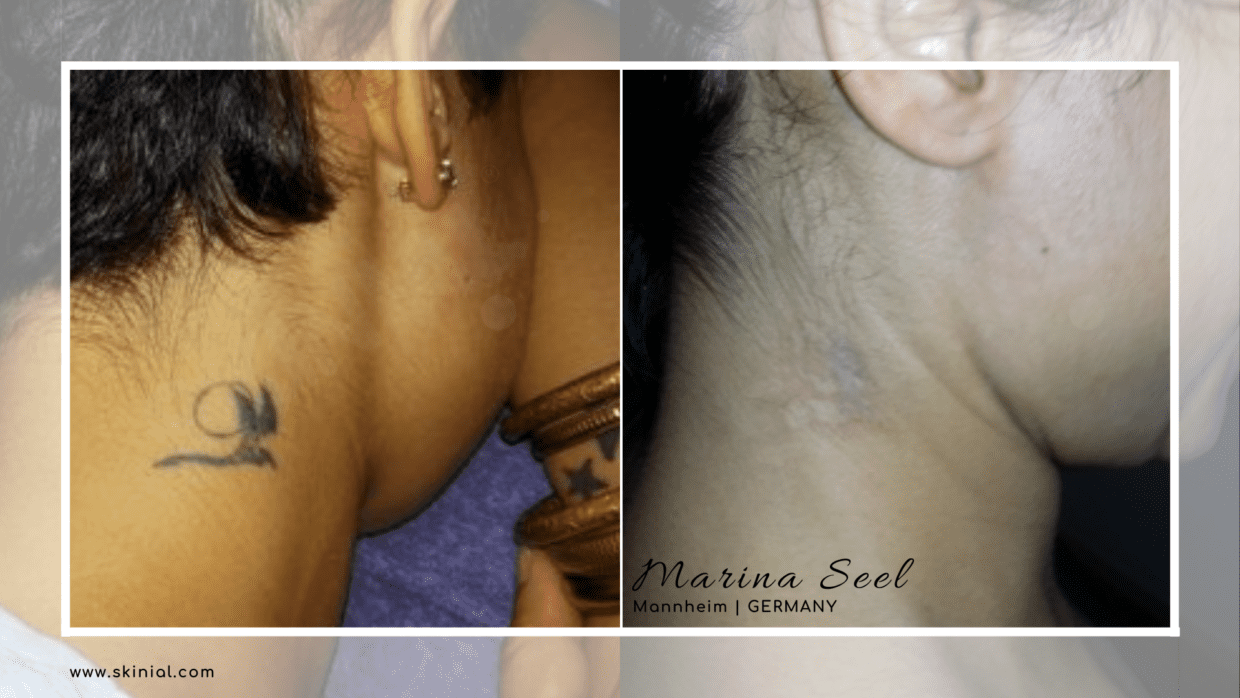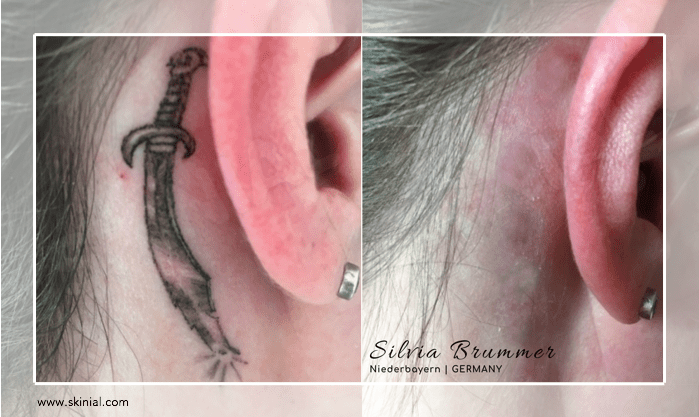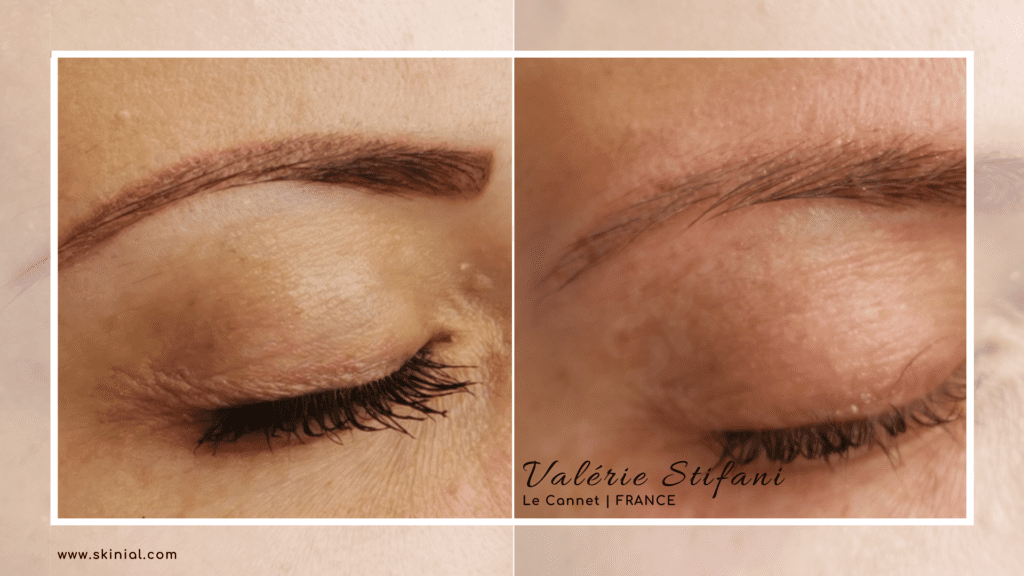You will find further information about how tattoo removal without laser works on the following topics below:
- Instead of a laser, a harmless natural serum is used.
- The tattoo ink is completely removed from the body.
- Less pain + less treatments + lower costs
- The patented SKINIAL method is a German technology that was developed together with doctors and pharmacists.
- SKINIAL has been used successfully in many countries around the world for over ten years.
Tattoo removal is a natural immune response
To correct or remove tattoos, PMU or microblading, the surface of the skin (epidermis) is roughened using a micropigmentation device.
A weak lactic acid solution is then dribbled on and massaged in. The solution seeps through the skin layers to the color pigments. The serum causes the protective covering around the color pigments, which previously would have prevented the skin from recognizing the color as a foreign body and rejecting it (or causing inflammation), to separate from the pigments. Suddenly, the skin's immune system recognizes the pigment color as a foreign body and initiates a rejection process that can take several days, depending on the amount of pigment. The rejected color collects on the skin surface in the scab and falls off after a few days.
The redness indicates that the skin is healing and after complete healing, the treated area is usually free of tattoo ink.

Greatly enlarged section through the layers of the skin. The blacks are tattoo color pigments
The FADING-method is an easy-to-learn, very gentle and therefore safe method, with a very low risk of unwanted side effects.
However, the skin only visibly repels the pigments up to a maximum of five minutes after the actual treatment. Then the internal wound healing process closes the skin openings again. Due to the short time of opening, not very much ink can escape. The advantage is that the client no longer sees any treatment traces shortly after the treatment and the skin irritation is less than with the complete removal in one treatment.
With the DOT-method, several small area of the epidermis will be removed by roughening. The underlying tattoo ink is rejected by the immune system as long as the crust covers the area. This usually happens over a period of one week to 10 days.
You can remove pigmentation on the body and face completely with both methods. However, the FADING-method removes less pigment at a time, is safer and gentler on the skin and is quite sufficient for many applications.
Fading
Removal
1. All colours and colour mixtures are easily removed or lightened
With the SKINIAL method not only tattoo colours and permanent make-up can be removed, but also lacquers and special mixtures. So successfully that the colour at the treated area is usually completely removed after the first treatment.
2. Only a few treatments are enough for a great success.
Compared to laser, the SKINIAL method requires considerably less treatment because the colour is really removed during each session and not just "faded". The removal of an entire tattoo or PMU therefore takes less time and the costs are often considerably lower.
3. No harmful paint residues or removal substances remain in the body
With the SKINIAL method the tattoo colour is pushed off to the skin surface during the wound healing process and leaves the body completely. The lactic acid used in this process is a physiological substance which the human body converts to glucose within a few hours, so that no harmful substances are left in the body.
4. Less pain, no burns, familiar terrain.
Tattoo or PMU removal using the SKNIAL method feels similar to the former tattoo. Pain, as it is caused by the enormous heat during laser removal, for example, does not occur with the SKINIAL method.
Compared to graffiti on a house wall, the removal of a tattoo, PMU or microblading is much more complex and difficult. This is because the skin is a living organ that reacts differently to treatment for each person. In order to get an early first impression of the results to be expected depending on the individual constitution and history, a detailed consultation is held before each treatment. In this consultation, personal expectations and realistically achievable results are discussed in detail. An additional tolerance test shows the first results on the basis of a test treated area in nature.
Generally speaking, many customers have the misconception that any tattoo or PMU can be removed in such a way that the skin looks the same after removal as it did before the tattoo. This is often the case, but cannot be guaranteed by any method - neither with nor without laser. There is no guarantee for scar-free removal, because the formation of scars depends on many factors, such as individual skin characteristics, genetic conditions and to a large extent on personal aftercare and care.
However, due to the natural products used in the SKINIAL method, the experience with SKINIAL is very good and the vast majority of tattoos could be removed so well that after some time the former tattoo was no longer visible to the naked eye. With the removal method, experience shows that success with small tattoos can be seen after only two to three treatments. Due to the waiting time between treatments (about eight to ten weeks, in some cases even longer to ensure complete healing of the skin), this is the case at the earliest six to nine months after the last session. The removal of larger tattoos requires correspondingly more time and is also associated with a greater risk of visible scars due to the larger number of areas treated. In the case of fading, healing can take days and scars are very unlikely.
To get a first impression of the results that can be achieved with the SKINIAL method, exemplary before-and-after pictures of the removal and correction of body tattoos, permanent make-up and microblading with the removal method and the fading method are shown on the right side. The pictures come from the archives of the SKINIAL studios, which use the treatment pictures not least for free and non-binding consultation for new customers.
Before the actual removal of the tattoo or PMU starts, a compatibility test is carried out to determine whether the treatment method is tolerated, how fast the healing process is and how well the colour pigments are removed. The cost for this is 70 Euro and means for both sides, the practitioner and the treated person, security and realistic expectations of the treatment result.
After a successful tolerance test, the PMU or tattoo removal is carried out. The total duration and number of treatments* strongly depends on the size and shape. About one hour per treatment must be reckoned with, which is usually charged at a rate of 150 to 220 euros. However, the exact costs are determined by each studio itself.
Avoid unwanted side effects with care and aftercare
After treatment, the regeneration of the treated site is influenced by many factors. In addition to the main factors influencing the general health situation and your immune system, genetic factors and the way in which they support healing have an impact on recovery.
Mostly the customers themselves are responsible for unwanted side effects. UV radiation on the unprotected skin, mechanical stress as well as moisture (friction of clothing, premature removal of scab, ...) and neglected care and follow-up of the treatment site are in addition to medical reasons and mechanical stress due to premature active exercise stresses are reasons why temporary hypertrophic scars or inflammation can form.
The treatment itself is rarely due to the hygienic design itself cause of the inflammation. For larger tattoos, the risk of scarring is of course higher than for little ones. To avoid complications, follow carefully the follow-up instructions to minimize the occurrence of side effects.
Our aftercare recommendations for satisfied customers
Best results thanks to ideal skin care after tattoo removal
Since the best tattoo removal is only as good as the subsequent aftercare and care, SKINIAL has also developed cosmetic care products at the highest level together with an Austrian pharmaceutical laboratory. These are specially tailored to the needs of the skin after laser-free PMU or tattoo removal and help to achieve optimal results. The aim of the care product series was and is to avoid possible side effects of the SKINIAL treatment as best as possible by supporting the healing of the skin and simplifying aftercare for customers.
You can find all of our care products and removal devices in the online shop: https://shop.skinial.com
In general, the following recommendations apply. You can obtain further information from your treating studio.



- Keep the treated area dry!
- Do not expose to strong sunlight!
- Avoid friction (clothing, belts, jewelery), do not scratch, do not close.
- Do not apply Scar-Care-Creme for better healing and faster regeneration until the crust is gone.
Even though the SKINIAL method is safe and harmless to health and the products comply with all legal regulations, as with any skin treatment, including tattoo removal, undesirable side effects may occasionally occur.
This manifest themselves among other things through itching, pain, scars, inflammation and allergic reactions. Before the first treatment, every client receives comprehensive oral and written information.
Of course, it is always possible that a treatment was not carried out correctly by a studio. However, this has nothing to do with the SKINIAL method or the SKINIAL products. Our statistics show that this risk is less than 0.5% of all treatments. In order to avoid treatment errors, we are constantly improving our training courses. We offer free follow-up training and exchange of experience between the studios and provide a database with medical advice and direct support in case of questions or problems.
All professionals who deal with skin treatment of any kind know that post-treatment has a decisive influence on the outcome of the treatment. Tattooists, dermatologists and beauticians alike have made this experience. That is why we inform our customers verbally and in writing after each treatment that the aftercare rules have to be observed.
While until a few years ago, tattoos and PMU were almost exclusively removed by laser, laser-free methods have been gaining ground for some time now. These methods, which were developed ten to 15 years ago but for a long time were only known to insiders, offer a number of advantages. They are gentle, harmless and, in contrast to lasers, really remove the color pigments from the body. With lasers, on the other hand, the color particles are only so much reduced in size that they are transported out of the uppermost layer of skin into the body and are therefore no longer visible, but remain in the body. As scientific studies show, for example by the Federal Office for Radiation Protection, this can lead to long-term negative consequences. Not least for this reason, it seems only logical that more and more beauticians, tattooists, dermatologists and also authorities are interested in laser-free removal methods, which have been recognised and regulated throughout Europe since 2017 - despite numerous resistances from the "laser lobby".
In order to keep unwelcome competition at bay, convinced laser users tried to discredit the laser-free methods for a long time. Completely without reason, but unfortunately with success. Thus, the arguments often put forward by doctors about the frightening scarring caused by the application of acids were taken over by the press without any tests and carried into the world. The result was an enormous but unfounded fear of laser-free methods and at the same time a high of the laser myth.
In reality, however, laser-free methods, such as the SKINIAL method, are skin-friendly methods that are based on an acid, but contain less acid than a normal salad dressing. It seems only logical that the acids used in laser-free methods cannot be the causal reason for scarring. Especially when they are applied only on small areas and in minimal doses. This is also confirmed by letters from independent ministries, such as the BAG - Federal Office of Public Health FOPH, Bern, Switzerland (10.5.2010) and the Ministry of Health and Youth in the Netherlands (13.6.2018).
Although scars usually do not occur during the laser-free treatment itself, if the treatment is carried out correctly by trained personnel, scarring can nevertheless occur. For example, existing burns from a previous unsuccessful laser treatment, strong sunlight or friction from clothing in the treated area, moisture, dirt infections, as well as too little or insufficient care and aftercare can lead to wound healing disorders and these in turn can cause scars. In addition, the individual personal condition of each person, i.e. the immune system, the health situation and genetic disposition, determines whether, how quickly and how well a wound heals and whether scars are formed.
Careful information of the customers is therefore the A & O of every treatment. After all, there is no point in customers chasing after false wishful thinking and believing that a tattoo made "for eternity" or a PMU can be removed 100% without visible skin damage - whether with or without laser. Even if the chances of laser-free removal are good, the chances and risks must be explained and explained in detail to each individual customer on the basis of a risk profile determined in the educational interview. Only in this way can customers assess the risks, expect realistic results and leave your studio as satisfied customers. Satisfied and happy, because thanks to SKINIAL nobody has to live with an unloved tattoo or PMU nowadays.
For large area applications, laser may still be an option, but not for small and medium-sized tattoos. People who want their pigmentation corrected or removed are not sick. In more and more countries around the world authorities only allow doctors to remove tattoos with lasers. This is the best proof that this method is not as safe as we have always been told. In the future everyone who deals with pigment paints, but also many other users, will offer the safe, cosmetic tattoo removal without laser. It is less complicated, faster and cheaper and, after careful training, anyone can do it * (* some countries have issued further regulations such as hygiene courses, etc.).

